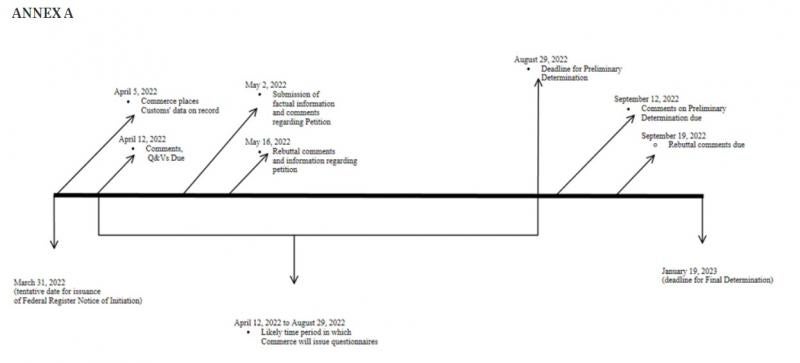On February 8, 2022, Auxin Solar Inc. filed a petition[i] requesting that the US Department of Commerce (Commerce) initiate a circumvention investigation into whether imports of crystalline silicon photovoltaic cells (CSPs) imported from Cambodia, Malaysia, Thailand or Vietnam (the third countries) are circumventing antidumping and countervailing duty orders (the orders) on CSPs from China.[ii] On March 25, 2022, pursuant to allegations in the petition, Commerce initiated a circumvention investigation (the initiation memorandum) that could profoundly affect the companies that import or rely on imported CSPs in the United States.[iii]
In this article, we provide information regarding (1) the possibility that Commerce will retroactively assess antidumping and countervailing duties on subject entries[iv] entered on or after March 31, 2022, or October 19, 2021, (2) the issues that Commerce will investigate and (3) the participation that may be necessary if parties wish to preserve the right to appeal.
In short:
-
If Commerce issues an affirmative preliminary circumvention determination, importers will be required to pay antidumping and countervailing duties on subject entries (cells and modules subject to the petition) entered into the United States on or after March 31, 2022 (when we assume that Commerce will publish the notice of initiation in the Federal Register).
-
This date, March 31, 2022, is important to solar developers since this is the default date for retroactive application of the tariffs.
-
If Commerce issues an affirmative preliminary circumvention determination, the default rule will allow Commerce to apply such determination as far back as March 31, 2022. Additionally, an exception may permit Commerce to apply such determination as far back as October 19, 2021.
-
According to our research, Commerce has not yet relied on the exception in the regulation permitting it to assess duties on entries entered prior to the date the Federal Register notice was published. This is likely because the relevant regulatory provision (19 C.F.R. § 351.225(l)(2)–(3)) went into effect on November 4, 2021.
-
The amount of tariffs contemplated under the petition range from 19% to 525%.
-
Commerce will investigate the following issues, among others, in the administrative proceeding: (1) whether the subject entries are of the same class or kind of merchandise as the subject merchandise (e., merchandise covered under the orders), (2) whether the subject entries were completed in the third countries before being imported into the United States, and (3) whether the process of assembly or completion of the subject entries in the third countries was minor or insignificant.
-
Throughout the circumvention investigation, and as set forth in Annex A, Commerce will provide interested parties with opportunities to participate.
-
A certain level of participation in the administrative proceedings may be necessary to preserve the right to appeal Commerce’s final determination to the US Court of International Trade.
IN DEPTH
DETAILED ANALYSIS
-
Potential for Retroactive Application of an Affirmative Circumvention Determination
In the event that Commerce issues an affirmative preliminary circumvention determination, it will begin ordering the suspension of and requiring cash deposit rates[v] for all unliquidated[vi] subject entries that have entered since Commerce published the notice of initiation in the federal register (which we assume will be March 31, 2022).[vii] In other words, importers will be required to pay antidumping and countervailing duties on subject entries (cells and modules subject to the petition) entered into the United States on or after March 31, 2022. March 31, 2022 is an important date to solar developers because, if Commerce relies on the default rule, it is the earliest date that Commerce will be able to apply an affirmative preliminary determination. If Commerce relies on the exception to the default rule, it could apply an affirmative determination as far back October 19, 2021. The amount of the tariffs contemplated under the petition range from 19% to 525%.
Additionally, an affirmative preliminary or final determination will open the door for Commerce to (at its own discretion or at the request of a party) require importers pay the applicable cash deposit rates for subject entries entered prior to the publication of the Federal Register notice.[viii] Below are the different points in the proceeding at which Commerce may collect or refund duties.
Following publication of the Federal Register notice, Commerce will order the continued suspension of liquidation and require cash deposit rates for the entries that would be covered in the event of an affirmative circumvention determination and for which liquidation is already suspended.[ix]
Following a preliminary affirmative determination, Commerce will require cash deposit rates for all unliquidated subject entries that were entered on or after the date of publication of the investigation in the Federal Register (i.e., March 31, 2022).[x] Additionally, following a preliminary affirmative determination, Commerce may (at its own discretion or at the request of a party) require cash deposit rates for unliquidated subject entries entered prior to the date on which the Federal Register notice was published (the earliest possible date being October 19, 2021).[xi] If an interested party makes such a request, Commerce may only consider an alternative date for retroactivity that is supported by evidence and specific argument.[xii] Our research indicates that Commerce has not yet had occasion to address the exception because the regulatory provision providing for the exception only recently went into effect.
Following a final affirmative determination, Commerce will take the same measures as it does for a preliminary determination.[xiii] A final affirmative determination also gives Commerce and an interested party a second opportunity to impose cash deposit rates on subject entries entered prior to the date on which the Federal Register notice was published.[xiv]
Following a negative final determination, Commerce will order US Customs and Border Protection (Customs) to terminate the suspension of liquidation and refund any cash deposits for subject entries.[xv]
-
Issues Commerce Will Consider in Its Circumvention Investigation
As set out in 19 U.S.C. § 1667j and discussed in the initiation memorandum, Commerce will investigate the following issues in the administrative proceeding:
-
Whether the subject entries are of the same class or kind of merchandise as the subject merchandise (e., merchandise covered under the orders).
-
Whether the subject entries were completed in the third countries before being imported into the United States.
-
Whether the process of assembly or completion of the subject entries in the third countries was minor or insignificant; in analyzing this issue, Commerce will look at:
-
The level of investment in the third countries by companies in China subject to the orders.
-
The level of research and development performed by the processors in the third country compared to the companies in China covered by the orders.
-
The nature of production process in the third countries compared to the production process in China.
-
The size and production capacity of facilities in the third countries compared to those in China.
-
The proportion of the value of merchandise resulting from the production process performed in the third countries.
-
-
Additional factors that Commerce will consider in this case include:
-
The pattern of trade and sourcing between China and the third countries, and the value of US imports of solar cells and modules.
-
Whether the companies in the third countries are affiliated with the manufacturers and exporters in China that are subject to the orders.
-
Whether the imports of merchandise shipped to the third countries for completion increased after the initiation of the investigations that resulted in the orders.
-
In the initiation memorandum, Commerce relied on information provided in the petition to determine that each of the factors above could be satisfied. For example, with respect to item (3)(a), Commerce cited information that the level of investment in China for polysilicon enrichment facilities was between $643 million and $2.1 billion from 2015 to 2020, whereas Chinese investments in the third countries ranged from $7.7 million to $160 million during the same period.[xvi] Similarly, with respect to item (3)(e), Commerce discussed information indicating that 70% of the value of solar panels accrues in China, not the third countries.[xvii]
-
Timing of the Investigation
Throughout the circumvention investigation, and as set forth in Annex A, Commerce will provide interested parties with opportunities to participate. A certain level of participation in the administrative proceedings may be necessary to preserve the right to appeal Commerce’s final determination to the US Court of International Trade.[xviii] Below, we identify several relevant events in the administrative proceeding, including some that may afford domestic interested parties[xix] the opportunity to participate in the administrative proceedings.
Again, in calculating certain dates below, we assume that Commerce will publish the notice on March 31, 2022. Additionally, it is important to keep in mind that Commerce may, at its discretion, “alter or extend any time limits” with respect to the submission of comments and factual information.[xx]
Preliminary and Final Determinations (August 29, 2022, and January 19, 2023). The two most important deadlines are Commerce’s deadlines for issuing the preliminary determination and the final determination. The regulations require Commerce to issue the preliminary determination within 150 days from the date of publication of the Federal Register notice.[xxi] Tentatively,[xxii] the deadline for the preliminary determination would be August 29, 2022. The statute provides that Commerce must, “to the maximum extent practicable[,]” make a final circumvention determination within 300 days of initiating the circumvention investigation.[xxiii] According to the unpublished Federal Register notice and the initiation memorandum, Commerce initiated the circumvention inquiries on March 25, 2022.[xxiv] Accordingly, the deadline for Commerce’s final determination is January 19, 2023.
Respondent Selection (April 5, 2022, to April 12, 2022). Five days after Commerce publishes the Federal Register notice, it will begin the process of respondent selection by putting Customs’ data on the record.[xxv] Using Customs’ data and “quantity and value questionnaires[,]” Commerce will select respondents.[xxvi] While the unpublished Federal Register notice states that comments may be submitted concerning Customs’ data, it does not specify which parties are eligible to submit comments.[xxvii] If Commerce follows its practice from antidumping and countervailing duty administrative proceedings, it will allow any interested party to comment on the selection of respondents, which would provide domestic interested parties an opportunity to participate in the proceeding. The quantity and value questionnaires and any other comments on Customs’ data or respondent selection must be submitted within seven days of Commerce placing Customs’ data on the record.[xxviii]
Questionnaires (likely between April 12, 2022, and August 29, 2022). At any time after initiating the investigation, Commerce may issue questionnaires to a “reasonable number of respondents” and verify any submissions it received.[xxix] Deadlines for responses to the questionnaires will be provided in the questionnaires themselves.[xxx] Fourteen days after Commerce receives questionnaire responses, an interested party (that is not the original submitter of the questionnaire response) may submit comments and factual information to rebut, clarify or correct information in the questionnaire response.[xxxi] Domestic interested parties may use the opportunity to comment on factual information and participate in the proceeding if they disagree with information provided in a questionnaire. Seven days after Commerce receives any such comments or information in rebuttal, the original submitter may submit additional comments and information in surrebuttal.[xxxii] While Commerce may issue these questionnaires at any point during the investigation, it is likely to issue most (if not all) questionnaires after selecting respondents but before issuing the preliminary determination.
Comments and Information Regarding the Petition (May 2, 2022, and May 16, 2022). Within 30 days of publication of the Federal Register notice, interested parties may submit comments and factual information that rebuts, clarifies or corrects factual information in the petition.[xxxiii] Domestic interested parties may submit such comments or information and participate in the proceeding. The comments and information would tentatively be due on May 2, 2022. Fourteen days after the submission of comments and information, the petitioner is allowed an opportunity to submit comments and factual information in rebuttal.[xxxiv] Such comments and information would, tentatively, be due on May 16, 2022.
Comments on the Preliminary Determination (September 12, 2022, and September 19, 2022). Unless Commerce specifies otherwise, 14 days after Commerce issues a preliminary determination, interested parties may submit comments on the preliminary determination.[xxxv] This represents yet another opportunity for domestic interested parties to participate in the proceeding. Seven days after Commerce receives any such comments, interested parties may submit comments in rebuttal.[xxxvi] Tentatively, those dates would be September 12, 2022, and September 19, 2022.
CONCLUSION
Given the material impact of the proposed tariff increase, the scope of suppliers impacted and the length of time of uncertainty before Commerce will indicate its decision as whether to apply retroactive tariffs to solar modules subject to the petition, we advise analyzing both (1) your current project portfolio and any projects that may be relying upon shipments of modules after October 19, 2021, to evaluate the potential impact of the petition on those projects and (2) future procurement strategy, as domestic producers of solar modules, while limited, are not subject to the potential retroactive tariffs.
ANNEX A

FOOTNOTES
[i] Auxin Solar’s Request for an Anti-Circumvention Ruling Pursuant to Section 781(B) of the Tariff Act of 1930, as Amended, A-570-979, C-570-980 (Feb. 8, 2022) (the petition).
[ii] See Crystalline Silicon Photovoltaic Cells, Whether or Not Assembled into Modules, From the People’s Republic of China: Amended Final Determination of Sales at Less Than Fair value, and Antidumping Duty Order, 77 Fed. Reg. 73,018 (Dec. 7, 2012); Crystalline Silicon Photovoltaic Cells, Whether or Not Assembled into Modules, from the People’s Republic of China: Countervailing Duty Order, 77 Fed. Reg. 73,017 (Dec. 7, 2012) (collectively, the orders).
[iii] See Crystalline Silicon Photovoltaic Cells, Whether or Not Assembled into Modules from the People’s Republic of China: Initiation of Circumvention Inquiries, from James Maeder to Lisa Wang, A-570-979, C-570-980 (Mar. 25, 2022) (the initiation memorandum); Crystalline Silicon Photovoltaic Cells, Whether or Not Assembled Into Modules, From the People’s Republic of China: Initiation of Circumvention Inquiry on the Antidumping Duty and Countervailing Duty Orders (unpublished) (Dep’t Commerce Mar. 25, 2022) (the unpublished FR notice”).
[iv] “Subject entries” refers to those entries of merchandise that are the subject of the circumvention investigation but are not currently within the scope of the orders.
[v] The cash deposit rate will an estimated amount of countervailing duties and antidumping duties applicable to the subject merchandise as determined in the most recent administrative reviews. See 19 C.F.R. § 351.212(a). The antidumping rates in the most recently completed antidumping duty administrative review were 238.95%, 106.39%, 68.93% and 50.33%, depending on the company. See Crystalline Silicon Photovoltaic Cells, Whether or Not Assembled Into
Modules, From the People’s Republic of China: Final Results of Antidumping Duty Administrative Review and Final Determination of No Shipments; 2017–2018, 85 Fed. Reg. 62,275, 62,276–77 (Dep’t Commerce Oct. 2, 2020). The countervailing duties rates for the most recently completed administrative review are 525.58% and 19.28%, depending on the company. See Crystalline Silicon Photovoltaic Cells, Whether or Not Assembled Into
Modules, From the People’s Republic of China: Final Results and Partial Rescission of Countervailing Duty
Administrative Review; 2018, 86 Fed. Reg. 48,393, 48,395 (Dep’t Commerce Aug. 30, 2021).
[vi] Liquidation is the “final computation or ascertainment of duties on entries.” 19 C.F.R. § 159.1. Generally, this means that while liability to pay antidumping or countervailing duties accrues upon entry, “the actual duty is not formally determined until after entry, and not paid until Customs liquidates.” Home Prod. Int’l, Inc. v. United States, 405 F. Supp. 3d 1368, 1372–73 (Ct. Int’l Trade 2019). It is important to note that, with limited exceptions that we do not think apply here, once an entry is liquidated, Commerce cannot assess any duties on that entry. Agro Dutch Indus. v. United States, 589 F.3d 1187, 1190 (Fed. Cir. 2009) (noting that “liquidation moots a party’s claims pertaining to liquidated entries”). Whether an entry is liquidated does not affect whether it may be moved from the port of entry.
[vii] It is unlikely that subject entries entered between March 31, 2022, and the date of the preliminary determination will have liquidated because entries that are not subject to an order of suspension of liquidation will liquidate 314 days after entry. See Announcement of a General Program Test Regarding Post-Entry Amendment Processing, 65 Fed. Reg. 70,872 (Dep’t Commerce Nov. 28, 2000).
[viii] The earliest date possible that Commerce could use is 314 days prior to the issuance of an affirmative preliminary determination (October 19, 2021), because any entries entered prior to that date (for which liquidation was not suspended) would have liquidated before the preliminary determination issued. At this time, we cannot say how far back Commerce is likely to go.
[ix] 19 C.F.R. § 351.226(l)(1).
[x] Id. § 351.226(l)(2)(ii). Commerce will also order the continued suspension of liquidation for these entries.
[xi] Id. § 351.226(l)(2)(iii)(A).
[xii] Id.
[xiii] See id. § 351.226(l)(3).
[xiv] Id. § 351.226(l)(3)(iii)(A).
[xv] 19 C.F.R. § 351.226(l)(4).
[xvi] Initiation memorandum at 7; see also petition at 61–64.
[xvii] Initiation memorandum at 9.
[xviii] See 19 U.S.C. § 1516a(a)(2)(A).
[xix] A domestic interested party includes a US manufacturer, producer or wholesaler of domestic like product, or a trade or business association (the majority of whose members manufacture, produce or wholesale domestic like product in the United States). See 19 U.S.C. § 1677(9)(C), (E).
[xx] 19 C.F.R. § 351.226(f)(7).
[xxi] Id. § 351.226(e)(1).
[xxii] This alert refers to “tentative” dates because Commerce has not yet published the notice of initiation in the federal register.
[xxiii] 19 U.S.C. § 1677j(f).
[xxiv] See initiation memorandum at 16; unpublished FR notice.
[xxv] Unpublished FR notice at 6.
[xxvi] Id.
[xxvii] See id.
[xxviii] Id.
[xxix] 19 C.F.R. § 351.226(f)(3).
[xxx] Id.
[xxxi] Id.
[xxxii] Id.
[xxxiii] 19 C.F.R. § 351.226(f)(2).
[xxxiv] Id.
[xxxv] See id. §§ 351.226(f)(4), 351.226(f)(5), (g)(1).
[xxxvi] Id. § 351.226(f)(4).





 />i
/>i

